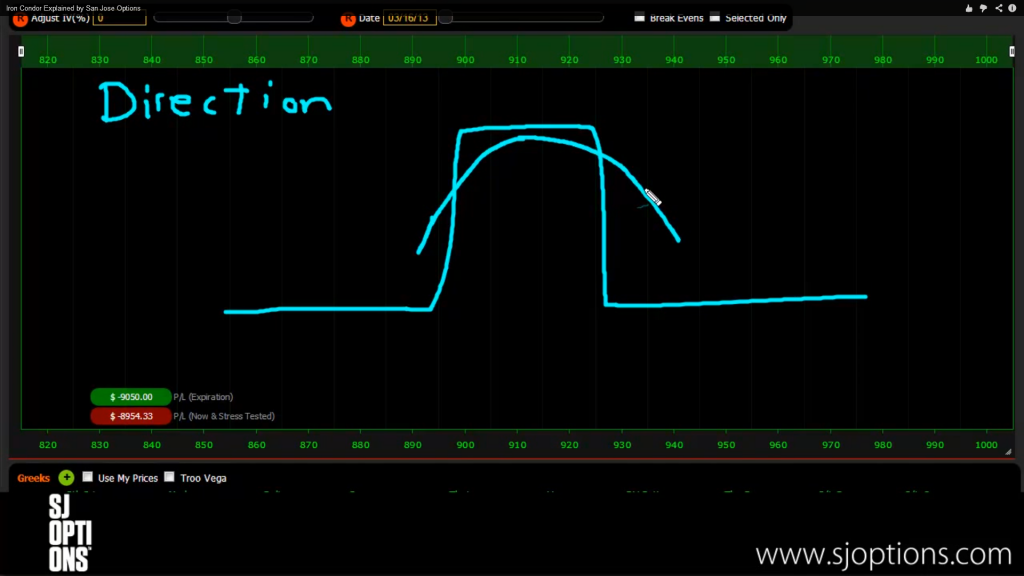Condor Options Explained
Post on: 9 Июль, 2015 No Comment

Buy 1 ITM Call (Lower Strike)
Limited Profit
Maximum profit for the long condor option strategy is achieved when the stock price falls between the 2 middle strikes at expiration. It can be derived that the maximum profit is equal to the difference in strike prices of the 2 lower striking calls less the initial debit taken to enter the trade.
The formula for calculating maximum profit is given below:
- Max Profit = Strike Price of Lower Strike Short Call — Strike Price of Lower Strike Long Call — Net Premium Paid — Commissions Paid
- Max Profit Achieved When Price of Underlying is in between the Strike Prices of the 2 Short Calls
Limited Risk
The maximum possible loss for a long condor option strategy is equal to the initial debit taken when entering the trade. It happens when the underlying stock price on expiration date is at or below the lowest strike price and also occurs when the stock price is at or above the highest strike price of all the options involved.
The formula for calculating maximum loss is given below:
- Max Loss = Net Premium Paid + Commissions Paid
- Max Loss Occurs When Price of Underlying = Strike Price of Higher Strike Long Call
Breakeven Point(s)
There are 2 break-even points for the condor position. The breakeven points can be calculated using the following formulae.
- Upper Breakeven Point = Strike Price of Highest Strike Long Call — Net Premium Received
- Lower Breakeven Point = Strike Price of Lowest Strike Long Call + Net Premium Received
Example
Suppose XYZ stock is trading at $45 in June. An options trader enters a condor trade by buying a JUL 35 call for $1100, writing a JUL 40 call for $700, writing another JUL 50 call for $200 and buying another JUL 55 call for $100. The net debit required to enter the trade is $300, which is also his maximum possible loss.
To further see why $300 is the maximum possible loss, lets examine what happens when the stock price falls to $35 or rise to $55 on expiration.
At $35, all the options expire worthless, so the initial debit taken of $300 is his maximum loss.
At $55, the long JUL 55 call expires worthless while the long JUL 35 call worth $2000 is used to offset the loss from the short JUL 40 call (worth $1500) and the short JUL 50 call (worth $500). Thus, the long condor trader still suffers the maximum loss that is equal to the $300 initial debit taken when entering the trade.
If instead on expiration in July, XYZ stock is still trading at $45, only the JUL 35 call and the JUL 40 call expires in the money. With his long JUL 35 call worth $1000 to offset the short JUL 40 call valued at $500 and the initial debit of $300, his net profit comes to $200.
The maximum profit for the condor trade may be low in relation to other trading strategies but it has a comparatively wider profit zone. In this example, maximum profit is achieved if the underlying stock price at expiration is anywhere between $40 and $50.
Note: While we have covered the use of this strategy with reference to stock options, the condor is equally applicable using ETF options, index options as well as options on futures .
Commissions
Commission charges can make a significant impact to overall profit or loss when implementing option spreads strategies. Their effect is even more pronounced for the condor as there are 4 legs involved in this trade compared to simpler strategies like the vertical spreads which have only 2 legs.
If you make multi-legged options trades frequently, you should check out the brokerage firm OptionsHouse.com where they charge a low fee of only $0.15 per contract (+$8.95 per trade).
Similar Strategies
The following strategies are similar to the condor in that they are also low volatility strategies that have limited profit potential and limited risk.














